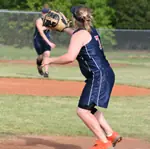
Successful softball pitching isn't just about arm-strength, the lower-half of a young fastpitch hurler can make a huge difference to a pitcher's effectiveness on the mound.
In this article, ASA shares three lower-half areas of focus that softball pitches can use to add velocity to their pitches and boost their accuracy.
Softball Pitching Fundamentals Tip No.1: Legs
The instep of the back foot initiates the drive forward for transfer of weight from the back foot (leg) toward the front foot (leg). The front knee (stride leg) lands flexed, but firms up as the weight transfers from the back leg to the front leg.
The hips should finish square to the plate after releasing the ball, with the followthrough into a good fielding position. (The shoulders and upper body finish tall with the shoulders finishing square with plate.)
Softball Pitching Fundamentals Tip No.2: Arm Downswing
On the downswing , maintain a long (not locked) lever (extension) on the downward path. A cocked wrist on approach to the release point allows for a maximum wrist snap. The wrist snap and release of the ball occurs between 7:00 and 5:00 (pitcher is the clock). The ball rolls off the middle finger (LOF).
The hand and arm finish out and up (longer lever), remaining loose and relaxed. The follow-through continues in direction of the ball on the LOF.
Short-arming (tight "v" with elbow) decreases the length of the lever (arm) and creates tension, therefore decreasing speed. When the arm circle takes away from the path of a perfect circle, or, leads a different direction (away from LOF), it will detract from solid fundamentals and adversely affect the pitch
Softball Pitching Fundamentals Tip No.3: Snap/Release
The pitcher releases the ball with their hand facing the catcher (imagine there is a dot in the middle of the hand, and as the pitcher releases the ball the dot on will face the catcher).
The wrist snap should produce 6-12 or 5-11:00 spin - determined by hand size and flexibility. Keep shoulders relaxed, meaning they will be slightly rolled forward (slumping) which will facilitate a smooth transition from snap to release to follow through.
NOTE: It is very important to teach your pitchers that the ball will go where their hand is pointing when they let go of it. While it sounds simple, it's the key to your pitcher's control. If they can learn this simple principle they can make adjustments immediately following a bad pitch.
Courtesy of Amateur Softball Association of America (ASA)– the National Governing Body of Softball in the United States.








Discuss This Article